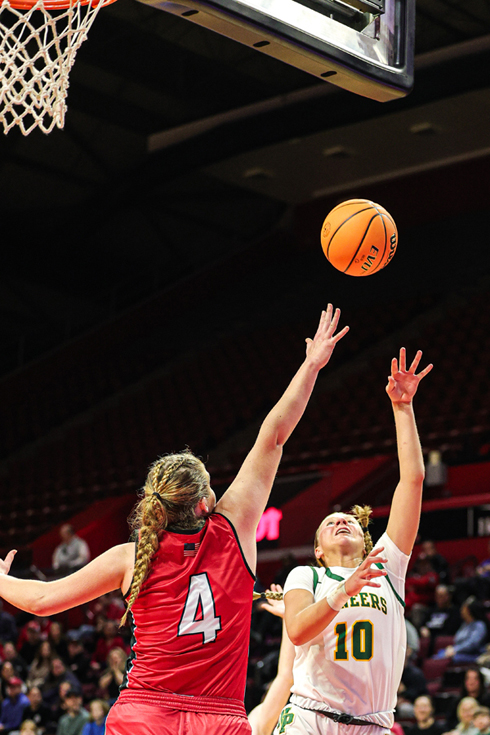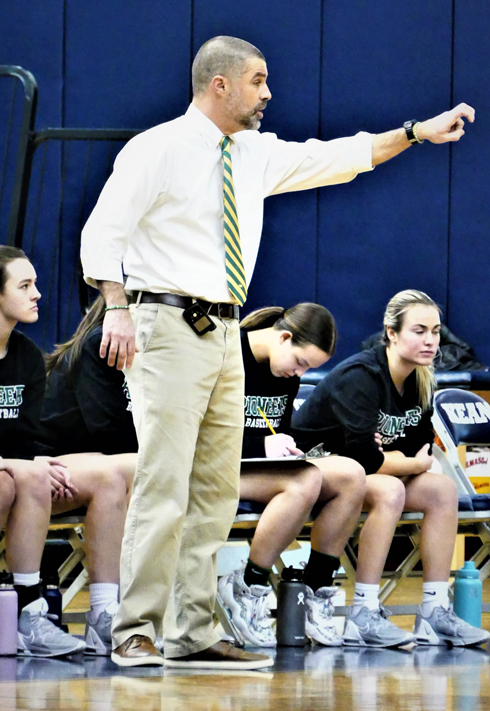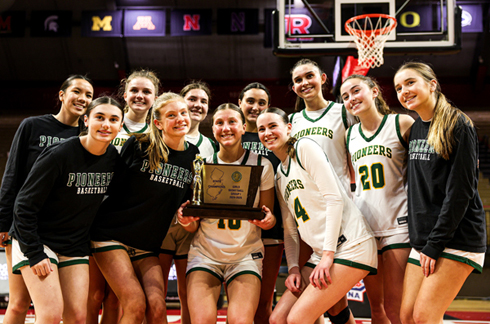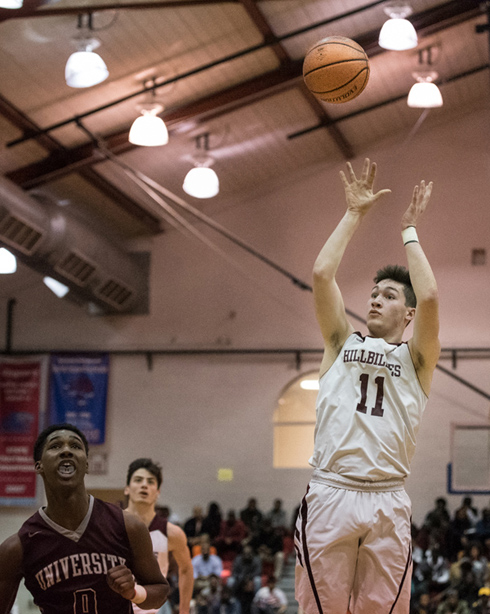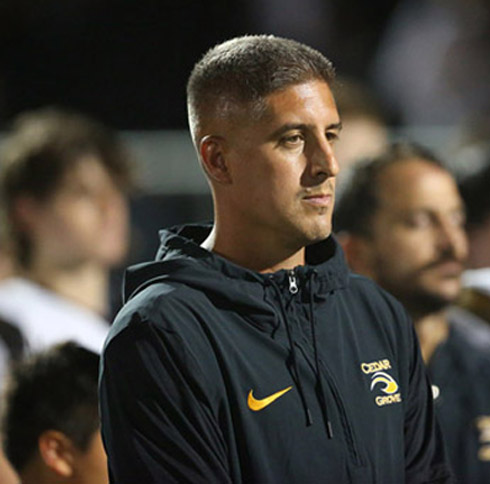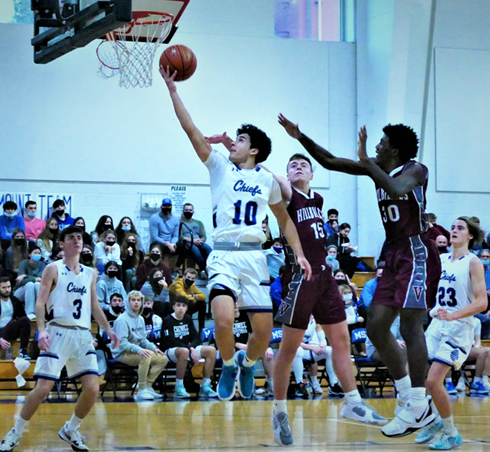
Insist on the Original - Solar Illuminations is your local certified dealer & installer. |
Standout guard Annie Conover (10) puts up a shot over Glen Ridge's Caitlin Hood (4) in the Group 1 state final last March at Rutgers Jersey Mike's Arena as veteran coach Cap Pazdera's talented Pioneers continued their more-than-decade long run of success as one of those rare small-school publics that just keeps on producing many outstanding teams. (SC photo and by Ayden Acebo)
The New Providence girls simply do not align with history when it comes to a period of uninterrupted success in reaching state sectional or overall group finals for most suburban girls and boys Group 1 or Group 2 public school programs which draw talent from only within their sending-district’s communities. Essex County boys basketball fans may remember the 2013-2014 Cedar Grove team directed by current Panthers Athletic Director and head football coach Rob Gogerty which finished 23-5 and won a North 1, Group 1 state sectional title, or the Verona boys squad of 2016-2017 who ended a superb 25-6, won the overall Group 1 state title, and also gave Non-Public A power Don Bosco Prep a run for its money before falling 61-51 in the first round of the NJSIAA Tournament of Champions. Then, there were the Caldwell boys of both 2021-2022 and 2022-2023 who achieved special hoops history for the Chiefs as the former squad made rarified air by reaching the semifinals of the Essex County Tournament, while the latter unit won the North 2, Group 2 state sectional crown along with advancing to the overall Group 2 final vs. powerful Manasquan. For those three small-school Super Essex Conference boys hoops programs the aforementioned achievements of statewide success could be considered generational achievements, or perhaps just once in a half century or more. The New Providence girls, who have captured four Group 1 state titles and a Group 2 state crown, are that very rare small-school team that has been able to simply reload each season over the course of the last decade and continue with supreme success. In addition to the 2025 Group 1 crown, the Pioneers have also captured Group 1 state titles in 2010, 2011 and 2015 and their Group 2 crown in 2023. That was before last season’s hard-fought 42-36 victory over Glen Ridge, which was making its first-ever appearance in a Group 1 final, as New Providence completed the 2024-2025 season with a school record for victories with 30 during a dynamic 30-2 state championship campaign which included 24 straight victories. New Providence returned just two starters in Annie Conover and Brenna Slattery from its 25-5 team from the season prior, a very talented squad which had lost to perennial Group 2 state power Manasquan in the Central Jersey, Group 2 title tilt. With three new starters in the lineup, veteran coach Cap Pazdera’s Pioneers not only won 30 games but knocked off that inevitable obstacle Manasquan, 55-44, to end the Shore Conference titan’s eight-year run of winning the CJG2 state sectional crown. Glen Ridge, with its finest team in program history in 2024-2025, had a tremendous run in winning a North 2, Group 1 state sectional title last winter, including a very satisfying victory over longtime nemesis University in the sectional final. And, the Ridgers led New Providence at halftime in the 2025 Group 1 state final at Rutgers Jersey Mike’s Arena before Slattery, Conover and company made the biggest plays down the stretch in the fourth quarter to help the Pioneers cop the Group 1 championship. It’s not easy for any Group 1 public school - especially without drawing players from beyond its borders – to continue a strong run as a legitimate state title contender for more than a season or perhaps two as the Caldwell boys had done. New Providence faced Glen Ridge on Dec. 30 in the Demarest Holiday Tournament in the two teams’ first meeting since the Group 1 final last March. The Pioneers, with five players hitting for double figures, including the irrepressible Conover who led the way with 16 points and 6 assists, defeated the Ridgers, 65-36, as the proverbial beat simply goes on for coach Pazdera and his Pioneers, who since 2019-2020 have won three Union County Tournament titles while putting together records of 27-4, 26-3, 28-3, 25-5, 30-2 and 7-0 so far this season with who knows what else could be in store in terms of Union County or state tournament success in 2026? New Providence returns four key players from the rotation that faced Glen Ridge last March with Conover, fellow seniors Megan Henn and Haley Kessler and precocious sophomore Addy Fitzgerald. Brenna Slattery graduated from last season’s elite-level team, but players such as her sister Anna, who had 10 points vs. Glen Ridge in the Dec. 30 contest, steps into a more prominent role this winter. The 2023-2024 squad featured a senior star in Grace Kinum, while the 2022-2023 team was led by senior Meghan Lammana, and the 2019-2020 team by Grace’s sister, Lindsay Kinum. The 2025-2026 New Providence squad improved to 10-0 on the season with a 55-36 victory over Fair Lawn on Thursday (Jan. 8) which followed this past Tuesday's (Jan. 6) 57-47 victory over Union Catholic as Kessler led the way with 22 points and Conover added 16. The Pioneers have a big upcoming Union County Conference showdown this week as they travel to meet undefeated Westfield (9-0) 4 p.m. Tuesday (Jan. 13) in Blue Devil country. While the high school program continues to flourish at New Providence the strong feeder program in town continues to produce talent. Add in the superb coaching of Pazdera and his staff, plus dedicated and the annual supply of talented players at the high school level in addition to strong family involvement and what you have produced on an annual basis is a small-school scholastic hoops program that is incomparable in many ways, and especially in a day and age when there are other public schools that take advantage of updated NJSIAA regulations which allow a student to attend a school outside their own hometown with the decision as to whether or not to be charged tuition up to the local Board of Education and school administration. The New Providence girls are undeniably unique, and their continued excellence simply reinforces the knowledge of just how special certain small-school teams, such as those aforementioned boys hoops squads from Cedar Grove, Verona and Caldwell, have been. Follow Sideline Chatter on 'X' @Chattermeister
Verona's 2016-2017 squad with Joey Zecchino (11) and a host of Hillbilly stars, Cedar Grove, under the direction of current AD and head football coach Rob Gogerty, and Caldwell with key perfromers including Cristian Talavara (10), are among small-school public schools that enjoyed strong state tournament runs in past seasons. (SC photos and by Jeff Stiefbold)
.
copyright 2005 Sideline Chatter - to comment contact the webmaster
|
|||||||||||||
|




